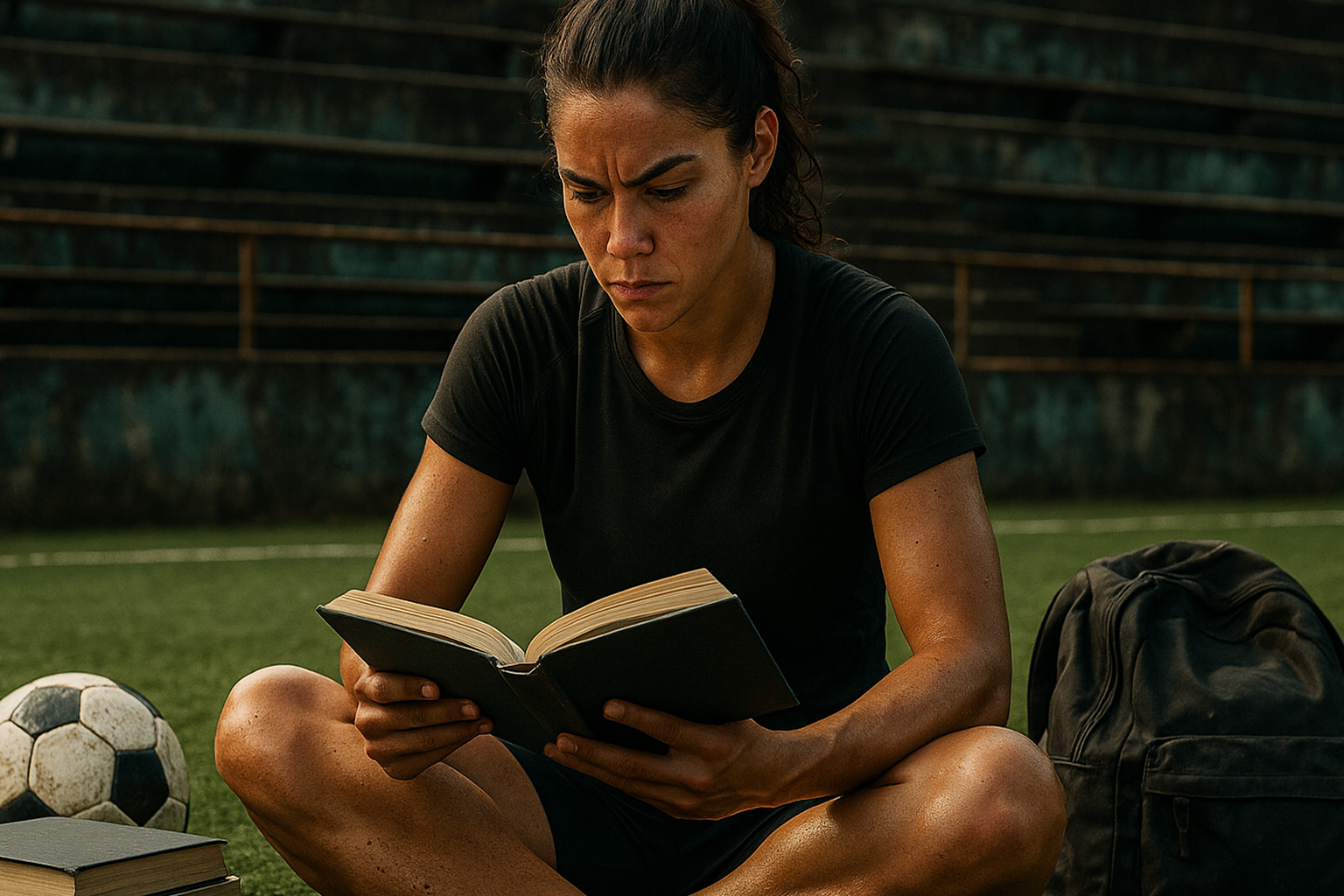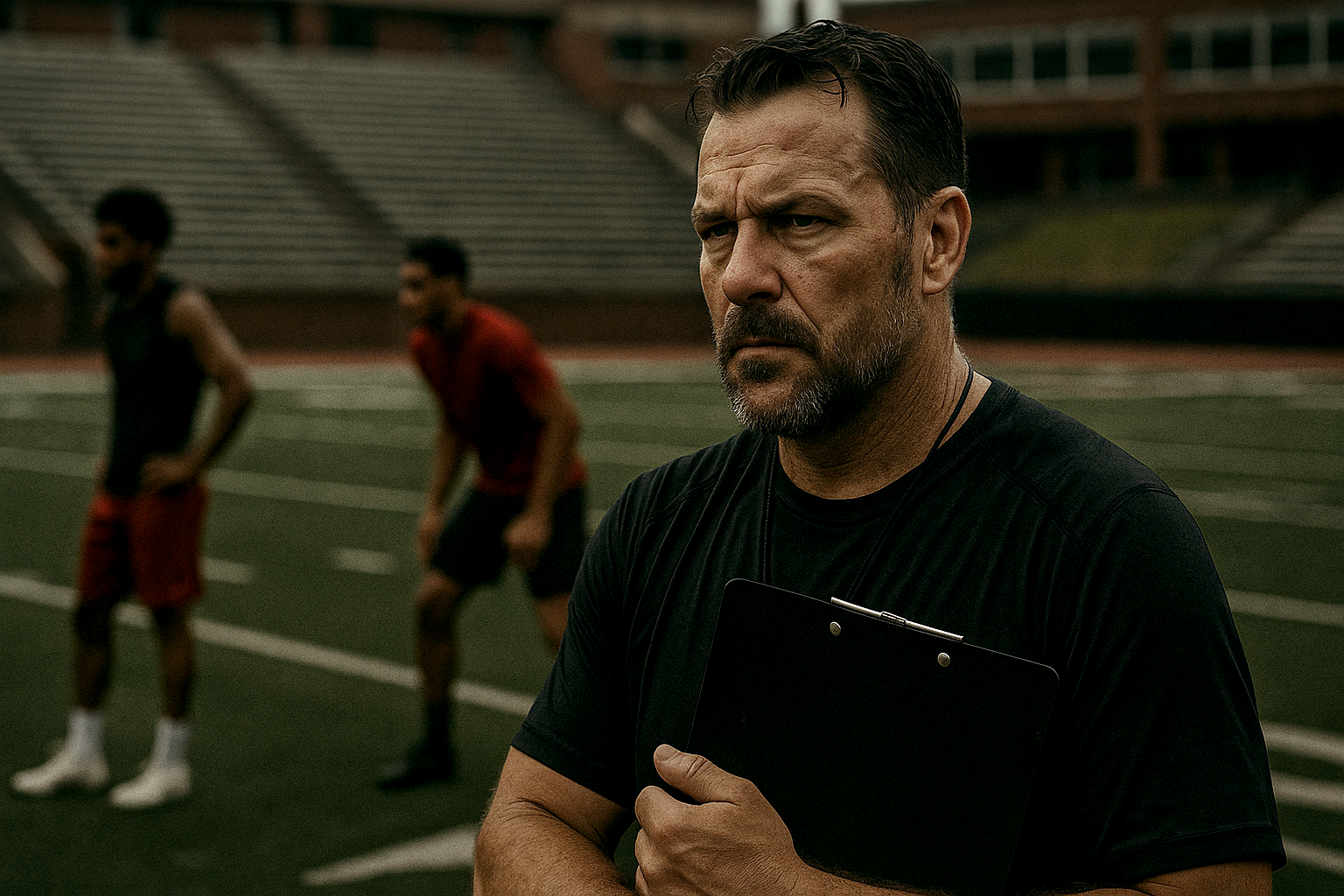Scholarship or walk-on? Know the difference. For many high school athletes, the goal of playing in college raises a key question: Do I go after a scholarship, or try to walk on?
Both paths can land you a roster spot – but the journey, support, and expectations look very different. This article breaks down how each path works, who qualifies, and what to expect once you're in.
UNDERSTANDING SCHOLARSHIP AND WALK-ON PATHS
Scholarship athletes are recruited by college programs and offered financial aid that covers some or all of the cost of attending school. This aid is given based on their athletic ability and potential to contribute to the team.
Walk-on athletes join a college team without receiving athletic financial aid at the start. Some are invited by coaches (called preferred walk-ons), while others try out without a guarantee of making the team.
The key distinctions between scholarship and walk-on athletes:
- Scholarship Athletes: Recruited by coaches and offered athletic financial aid
- Walk-On Athletes: Join the team without athletic aid initially
In NCAA Division I athletics, about half of athletes receive athletic scholarships, while the other half are walk-ons. These numbers vary by sport and division.
Walk-on athletes fall into three main types:
- Preferred Walk-Ons: Invited to join the team but without scholarship money
- Recruited Walk-Ons: In contact with coaches but must try out
- Unrecruited Walk-Ons: Initiate contact themselves and attend open tryouts
These two paths shape the athlete experience differently – in finances, playing time, and access to resources.
HOW HOUSE V. NCAA SETTLEMENT IMPACTS WALK-ONS
The House v. NCAA settlement imposes hard roster caps across most sports. Football shrinks to 105 players (down from 125-180); baseball drops to 34 (from 41). That means fewer total spots. Walk-ons, who usually fill depth roles, are first on the chopping block.
TEMPORARY SHIELD: DSA STATUS (CLASS OF 2025 ONLY)
To soften the blow, the agreement introduces “Designated Student-Athlete” (DSA) status. Athletes on a roster or actively recruited by April 7, 2025 – including preferred and recruited walk-ons – can be rostered in 2025–26 even if it exceeds the new caps. But this protection is short-term. After that, the caps kick in across the board.
WALK-ON PATH GETS NARROWER
With fewer slots, coaches will be more selective. Preferred walk-ons – once a reliable backdoor – now must offer immediate value or future scholarship potential. For unrecruited or late-blooming athletes, the shot to “prove it” may never come.
2026 AND BEYOND: NO EXCEPTIONS
Starting with the Class of 2026, no DSA exemptions apply. Everyone – scholarship or not – must fit under the cap.
That includes:
- Preferred walk-ons: Now competing for fewer invites
- Recruited walk-ons: Less likely to be pursued
- Unrecruited walk-ons: Likely to be cut out entirely
THE END OF THE OLD WALK-ON ROUTE
For years, walk-ons carved out roles, earned scholarships, even became stars. That pipeline isn’t gone – but it’s closing fast. Starting in 2026, the odds get steeper, the room tighter, and the path narrower. For many athletes, the traditional walk-on journey may no longer exist.
HOW COLLEGE PROGRAMS AWARD SCHOLARSHIPS
College sports scholarships come in two main forms: full and partial. A full scholarship covers tuition, fees, room, board, and books. A partial scholarship covers only a portion of these costs.
Previously, scholarship distribution for athletes depended on whether their sport was a headcount sport (which only allowed full scholarships to be distributed) or an equivalency sport (which allowed coaches to distribute scholarship money among several athletes).
As of the 2025-2026 school year, these distinctions have essentially been eliminated and coaches now have more latitude and flexibility to assign scholarship money where it is needed.
While the NCAA hasn’t officially reclassified all sports as equivalency sports, in practice, the new model allows coaches in every sport to allocate aid more like equivalency sports – mixing full and partial scholarships based on team needs.
Coaches evaluate athletes based on:
- Performance at camps or showcases
- Game film and in-person scouting
- Position needs on the team
- Character and team fit
- Academic standing
Learn about the 14 essentials college coaches look for in student athletes.
Scholarship renewal often depends on athletic performance, academic eligibility, and behavior. Some scholarships are one-year agreements that must be renewed, while others may cover multiple years.
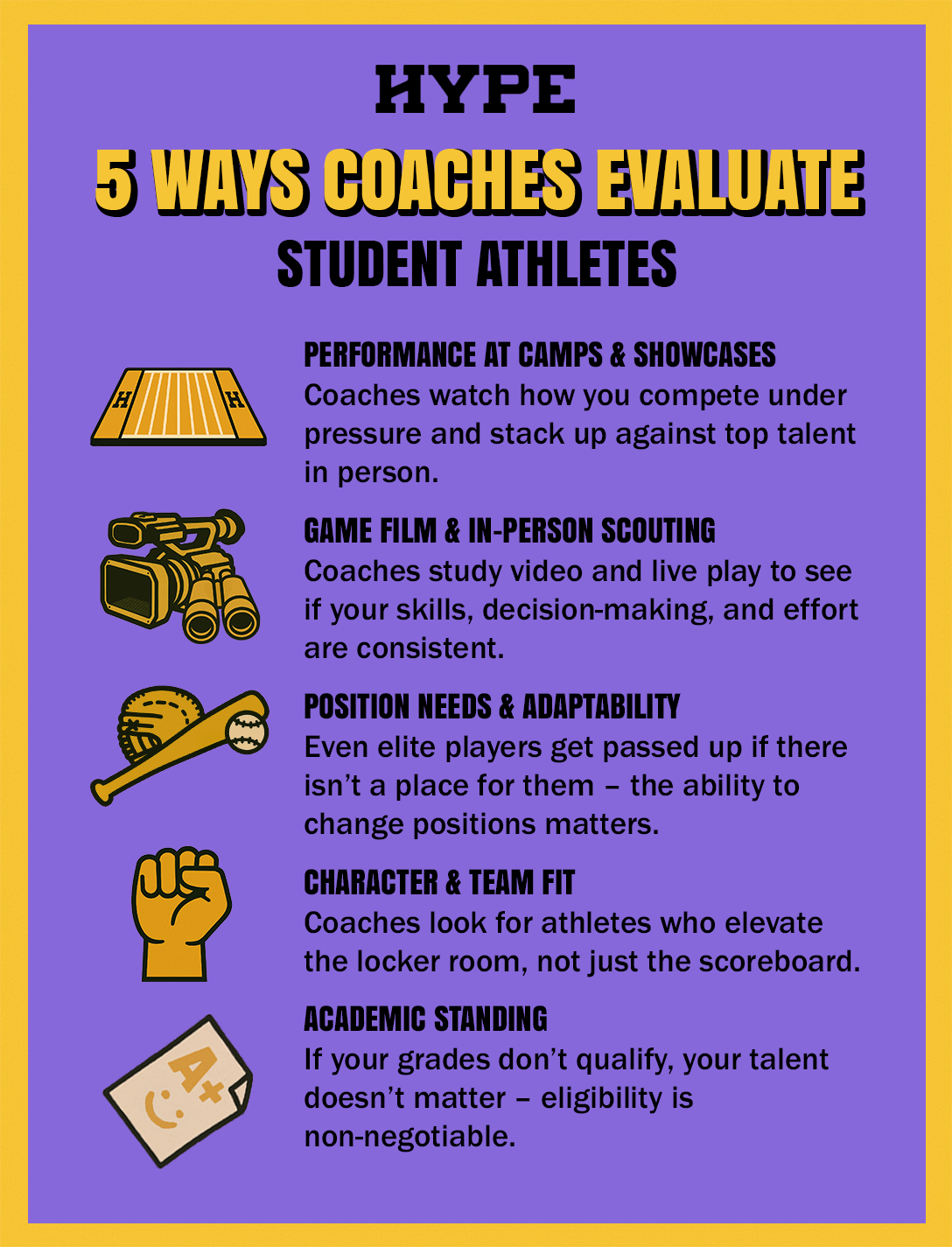
CAN WALK-ONS GET SCHOLARSHIPS LATER?
Yes, walk-on athletes can earn athletic scholarships after joining a college team – but, as noted above, the walk-on journey is shifting and becoming more difficult.
The opportunity for a walk-on to get a scholarship later on depends on available scholarship funding and roster space – which has become more restrictive after House v. NCAA. Still, coaches are likely to reward walk-on athletes who perform well, maintain good grades, and fill team needs.
The typical timeline for walk-ons to earn scholarships has historically ranged from one to three seasons. Coaches evaluate players each year, and scholarships may become available when scholarship athletes graduate, transfer, or leave the program.
Factors that increase a walk-on's chances of earning a scholarship include:
- Consistent Performance: Showing steady improvement and reliability
- Team Needs: Filling specific positions or roles the team needs
- Academic Excellence: Maintaining strong grades and eligibility
- Leadership: Contributing positively to team culture
Success stories exist at all levels, too. Baker Mayfield began as a walk-on at Texas Tech before transferring to Oklahoma, earning a scholarship, winning the Heisman Trophy, and becoming an NFL first-round draft pick. Many other walk-ons have earned partial scholarships after proving their value over one or more seasons.
While the path is becoming more difficult, it’s not impossible.
FINANCIAL AND ACADEMIC REALITIES FOR BOTH PATHS
The financial difference between walk-ons and scholarship athletes is significant. Walk-ons pay for college through personal funds, academic scholarships, or need-based financial aid. Scholarship athletes receive athletic aid that covers part or all of their expenses.
The financial reality of being a walk-on vs. scholarship athlete:
- Walk-on athlete financial reality:
- Can earn athletic scholarships in future years based on performance
- Pay full tuition and expenses unless they receive non-athletic aid
- Often apply for academic scholarships and need-based aid
- May work part-time jobs to cover costs
- Scholarship athlete financial reality:
- Receive athletic aid covering some or all college costs
- Must maintain athletic and academic performance to keep scholarships
- May receive additional benefits like priority registration or tutoring
- Scholarships can be one-year or multi-year agreements
Many walk-ons use the Free Application for Federal Student Aid (FAFSA) to qualify for grants and loans. Academic scholarships based on GPA and test scores can also help offset costs. In Division III, where athletic scholarships aren't offered, about 80% of athletes receive some form of academic or need-based aid.
Both paths present time management challenges. All college athletes balance practice, competition, travel, and academics. Walk-ons may have additional pressures if they work part-time jobs to fund their education. Scholarship athletes often face performance expectations tied to their financial aid.
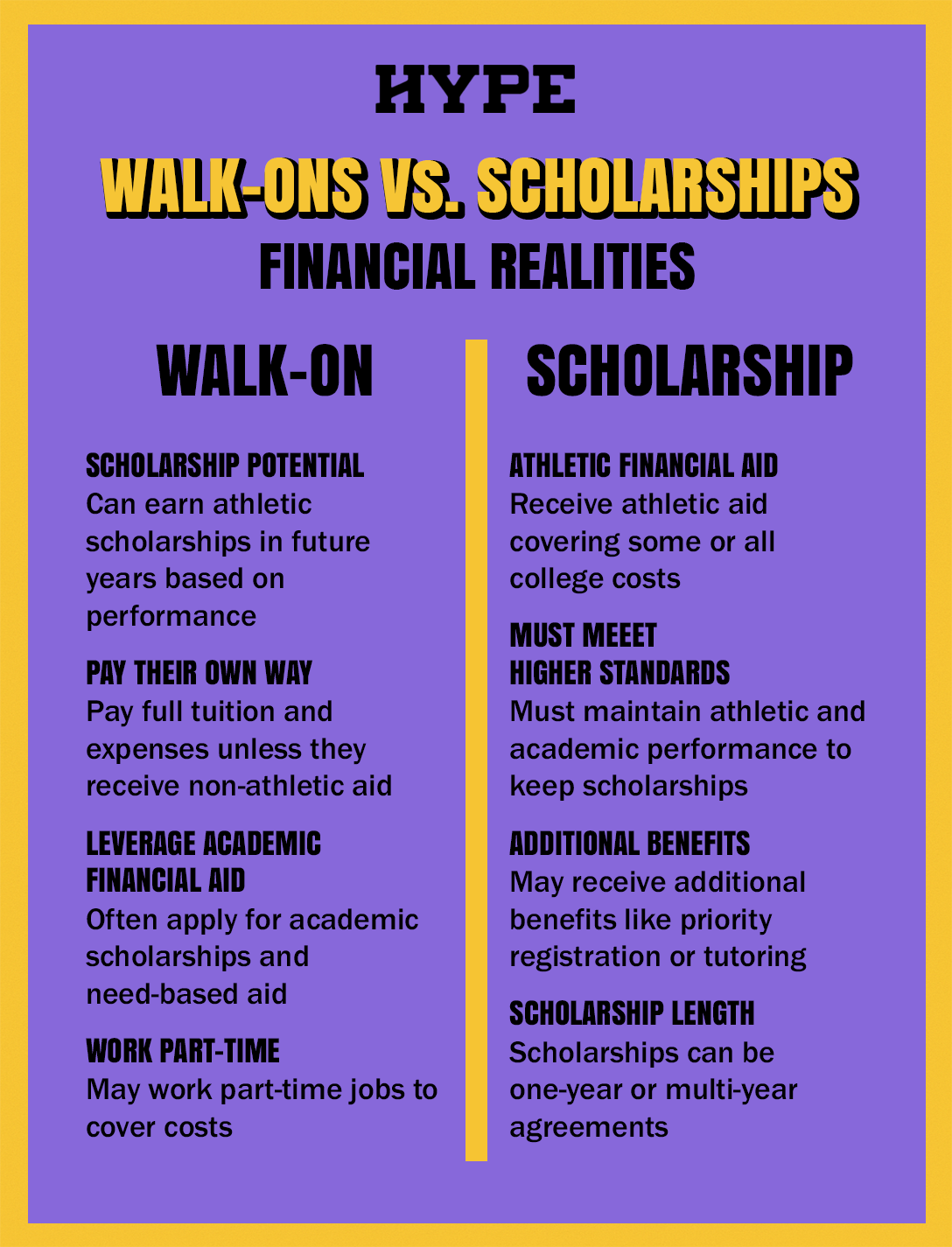
EMOTIONAL & MOTIVATIONAL FACTORS
The mental side of being a walk-on versus a scholarship athlete presents different challenges. Understanding these differences can help athletes prepare for the emotional journey ahead.
Pressure Differences:
- Scholarship athletes often feel pressure to perform to justify their funding
- Walk-ons feel pressure to prove they belong and earn recognition
- Both groups face high expectations, but the source of pressure differs
Team dynamics can be affected by scholarship status. In some programs, all athletes are treated equally regardless of scholarship status. In others, there may be subtle or obvious differences in how scholarship and non-scholarship players are treated, from playing time to equipment access.
Motivational differences of scholarship athletes vs. walk-on athletes:
- Scholarship athletes may be driven by external rewards (keeping their scholarship, professional opportunities)
- Walk-ons often rely on internal motivation (love of the sport, personal goals, proving doubters wrong)
Mental health challenges exist for both groups.
Scholarship athletes may worry about losing their funding due to injury, performance issues, or life circumstances. University of Memphis track athlete Cassandra Harding recalls when she found out she was pregnant: “First thing [I thought] is like, 'Oh my God, I'm going to lose my scholarship. What am I going to do?’ The only thing I was thinking of was track.”
Walk-ons may struggle with feelings of being overlooked or undervalued. UCLA walk-on turned NFL prospect Carson Schwesinger said in an interview with the Los Angeles Times: “There’s a level of discipline you have to have when you start as a walk-on. Kind of just working harder than everybody… and really just having that mindset that there’s not any work you’re not willing to do.”
These are different pressures, but both real. And both groups benefit from mental health resources and supportive team environments.
STEP-BY-STEP: BECOMING A WALK-ON
If you're considering the walk-on route, here's how to approach it:
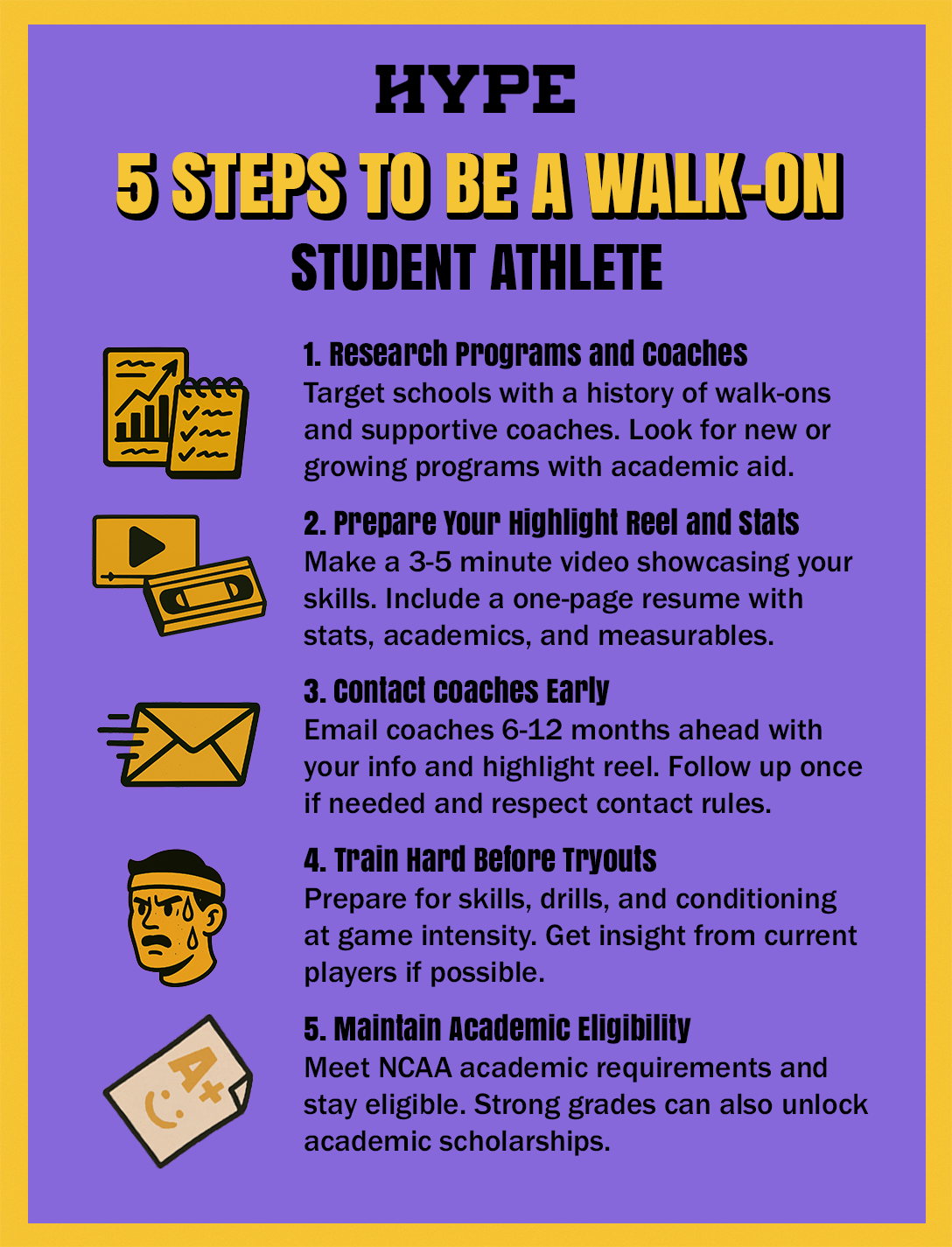
TLDR – 5 steps to becoming a walk-on athlete:
1. Research programs and coaches: Target schools with a history of walk-ons and supportive coaches. Look for new or growing programs with academic aid.
2. Prepare your highlight reel and stats: Make a 3-5 minute video showcasing your skills. Include a one-page resume with stats, academics, and measurables.
3. Contact coaches early: Email coaches 6-12 months ahead with your info and highlight reel. Follow up once if needed and respect contact rules.
4. Train hard before tryouts: Prepare for skills, drills, and conditioning at game intensity. Get insight from current players if possible.
5. Maintain academic eligibility: Meet NCAA academic requirements and stay eligible. Strong grades can also unlock academic scholarships.
1. RESEARCH PROGRAMS AND COACHES
Look for schools where walk-ons have succeeded in the past. Review team rosters to find programs with higher numbers of walk-ons. Research coaches' attitudes toward non-scholarship players by reading interviews or talking to former players.
Programs with recent coaching changes or those building new programs often have more walk-on opportunities. Schools with strong academic scholarships can make walking on more financially feasible.
2. PREPARE YOUR HIGHLIGHT REEL AND STATS
Create a 3-5 minute video showing your best plays and skills.
What to include in an athletic highlight reel:
- Game footage showing technical ability
- Clips demonstrating athleticism and sport IQ
- Clear identification (jersey number, position)
- A variety of situations and skills
Accompany your video with a one-page athletic resume listing:
- Key statistics and accomplishments
- Academic information (GPA, test scores)
- Contact information for coaches who can provide references
- Measurables relevant to your sport (height, weight, speed, etc.)
3. CONTACT THE STAFF EARLY
Reach out to coaches 6-12 months before you plan to enroll. Send a brief, professional email.
What to include in an introductory email to coaches:
- Your name, position, and graduation year
- Why you're interested in their program specifically
- Request for information about walk-on opportunities
- Academic and athletic achievements
- Link to your highlight video
Follow up once after 1-2 weeks if you don't receive a response. Many coaches are busy and receive hundreds of emails, so persistence (without being annoying) is important. Don’t forget to factor official athlete-coach communication periods into when to expect a response, as well.
4. TRAIN HARD BEFORE TRYOUTS
Once you know the tryout format, train specifically for those demands.
Most tryouts include:
- Sport-specific skill evaluations
- Conditioning tests
- Scrimmage situations
- Team drills
Train at game intensity to prepare for the physical demands. Ask current players about typical tryout formats if possible. Mental preparation is equally important – tryouts are stressful, and coaches often evaluate how players handle pressure.
5. MAINTAIN ACADEMIC ELIGIBILITY
Walk-ons must meet the same eligibility requirements as scholarship athletes.
Academic eligibility requirements for prospective NCAA athletes:
- Complete required NCAA core courses in high school
- Maintain minimum GPA requirements
- Register with the NCAA Eligibility Center
Once in college, continue prioritizing academics. Strong grades not only keep you eligible but may qualify you for academic scholarships that ease the financial burden of being a walk-on.
STEP-BY-STEP: BECOMING A SCHOLARSHIP ATHLETE
Earning an athletic scholarship isn’t luck. It’s strategy, grit, and follow-through. Here’s how to attack the process and maximize your shot at getting funded to play.
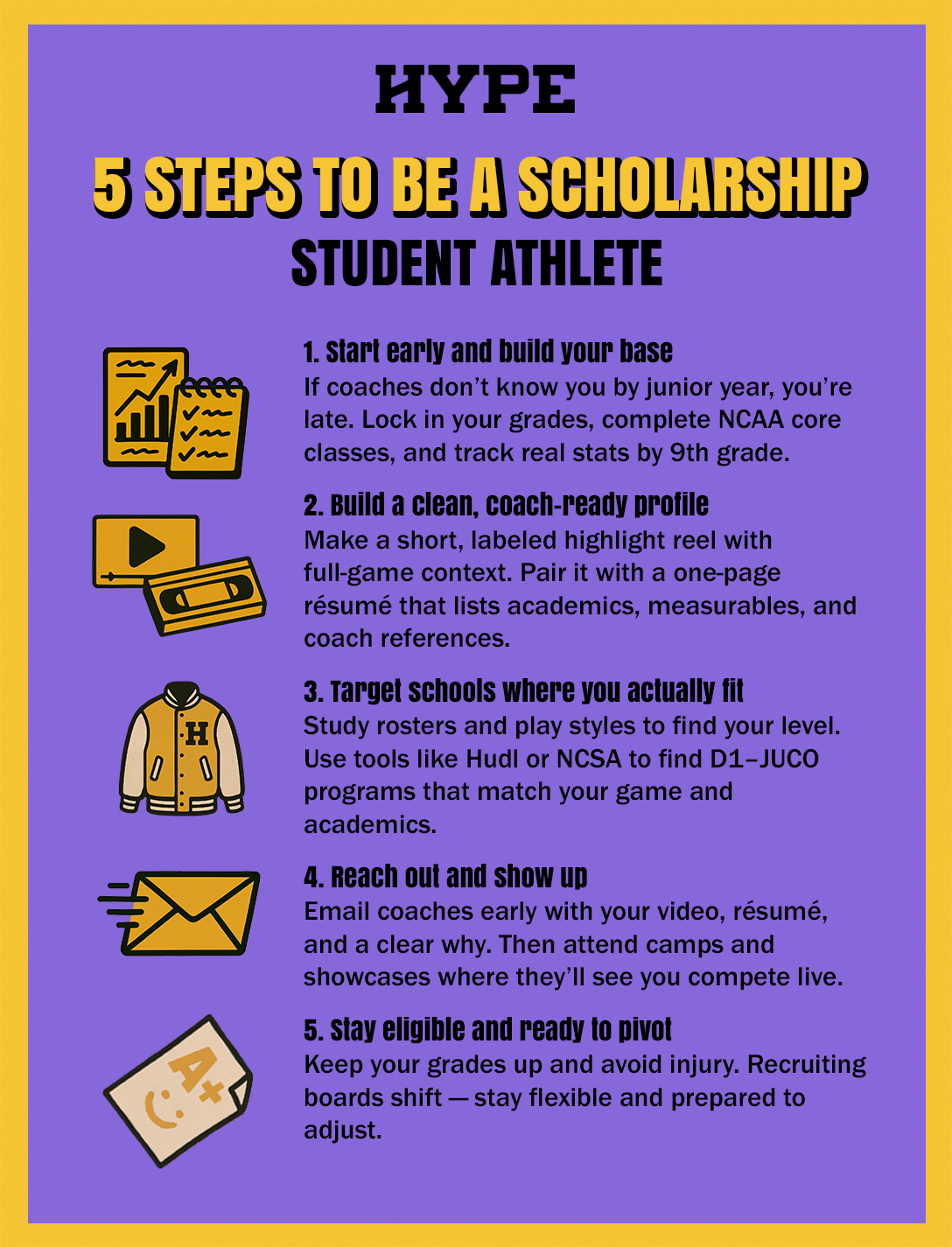
TLDR – 5 steps to becoming a scholarship athlete:
1. Start early and build your base: If coaches don’t know you by junior year, you’re late. Lock in your grades, complete NCAA core classes, and track real stats by 9th grade.
2. Build a clean, coach-ready profile: Make a short, labeled highlight reel with full-game context. Pair it with a one-page résumé that lists academics, measurables, and coach references.
3. Target schools where you actually fit: Study rosters and play styles to find your level. Use tools like Hudl or NCSA to find D1–JUCO programs that match your game and academics.
4. Reach out and show up: Email coaches early with your video, résumé, and a clear why. Then attend camps and showcases where they’ll see you compete live.
5. Stay eligible and ready to pivot: Keep your grades up and avoid injury. Recruiting boards shift — stay flexible and prepared to adjust.
1. START EARLY – LIKE, REALLY EARLY
If you're not on a coach’s radar by junior year, you're already playing catch-up.
- Start your recruiting plan by 9th grade. Build your academic and athletic foundation early.
- Keep a clean transcript. NCAA Division I and II programs require minimum GPA and core course completion. You need at least a 2.3 GPA and 10 core classes completed by the end of your junior year to qualify under NCAA standards.
- Track and record performance benchmarks: verified times, stats, and wins matter more than just potential.
2. BUILD YOUR RECRUITING PROFILE AND HIGHLIGHT REEL
This is your sports résumé – not a hype tape for your friends.
- Create a 3-5 minute highlight video:
- Lead with your best plays.
- Show full game context when possible – not just isolated highlights.
- Clearly label your name, position, jersey number, and contact info.
- Make a one-page athletic résumé:
- Academic data (GPA, SAT/ACT if applicable)
- Physical stats (height, weight, position, speed)
- Contact info for coaches or trainers as references
3. RESEARCH REALISTIC PROGRAM FITS
Forget fantasy programs. Focus on where you can play.
- Look up rosters, watch team play styles, and read recruiting bios to understand what kind of athletes each school targets.
- Use platforms like NCSA, FieldLevel, or Hudl to identify schools that match your ability and academic level.
- Target programs across different divisions – DI, DII, DIII, NAIA, and JUCO all offer scholarship pathways, though amounts and availability vary.
4. EMAIL COACHES
Don’t wait to be discovered. Be the one who introduces yourself.
- Email college coaches by sophomore year (earlier for high-visibility sports like women's soccer and gymnastics).
- What to include:
- Who you are: name, class year, position
- Why you’re interested in their program
- Your current GPA, test scores, and key stats
- A link to your video and résumé
- Follow up if you don’t hear back. Be respectful, not spammy. And don’t forget: The NCAA has contact rules – DI coaches can't respond to underclassmen before June 15 after sophomore year (varies by sport).
5. ATTEND CAMPS, COMBINES, SHOWCASES
Your inbox won’t get you a scholarship. Your in-person performance might.
- Prioritize college-hosted camps – it gets you in front of their staff.
- For national showcases, choose events known for strong coach attendance.
- Be ready to compete at your best. Coaches aren’t just looking at talent – they’re watching attitude, coachability, and how you carry yourself.
6. STAY ELIGIBLE, STAY READY
Scholarship offers are conditional. You need to keep proving yourself.
- Maintain academic eligibility (NCAA, NAIA, or NJCAA standards).
- Stay injury-free with smart training and proper recovery.
- Stay updated – coaches, programs, and scholarships shift constantly.
7. BE HONEST WITH YOURSELF & STAY HUNGRY
Not everyone gets a full ride. Most athletes piece together scholarships from multiple sources: athletics, academics, and need-based aid.
- If a coach says you're being “recruited as a preferred walk-on,” ask questions – that’s not a scholarship (but it’s also not necessarily a bad thing).
- Read your offer carefully. Some are year-to-year, others multi-year.
- Keep working. Even if you’re offered money, it can be reduced or cut based on performance and budget shifts.
DECIDING WHICH PATH IS BEST FOR YOU
Choosing between pursuing scholarships and walking on depends on several factors. Consider these questions to help guide your decision:
- Athletic Level: Are you being actively recruited by college coaches? If multiple programs are showing interest, a scholarship may be realistic.
- Financial Situation: Can you or your family afford college without athletic aid? Walking on requires covering tuition and expenses through other means.
- Program Fit: Would you rather be on scholarship at a smaller program or walk on at a more prestigious one? Some athletes prefer playing time at a lower division over limited opportunities at a higher level.
- Academic Goals: Which path better supports your educational priorities? Sometimes academic scholarships at one school outweigh partial athletic scholarships at another.
Scholarship offers typically come after a recruitment process where coaches evaluate you through games, camps, or showcases. If you're receiving official visits or specific financial discussions, you're on the scholarship track. If coaches express interest but don't offer aid, you might be considered for preferred walk-on status.
The decision often comes down to balancing multiple factors. Some athletes turn down partial scholarships at smaller schools to walk on at their dream program. Others prioritize the financial security of a scholarship, even if it means attending a less prestigious school.
With the NCAA's 2025 roster limits, walk-on spots have become more competitive at many schools. This makes the decision even more important, as fewer walk-on opportunities may be available in some sports.
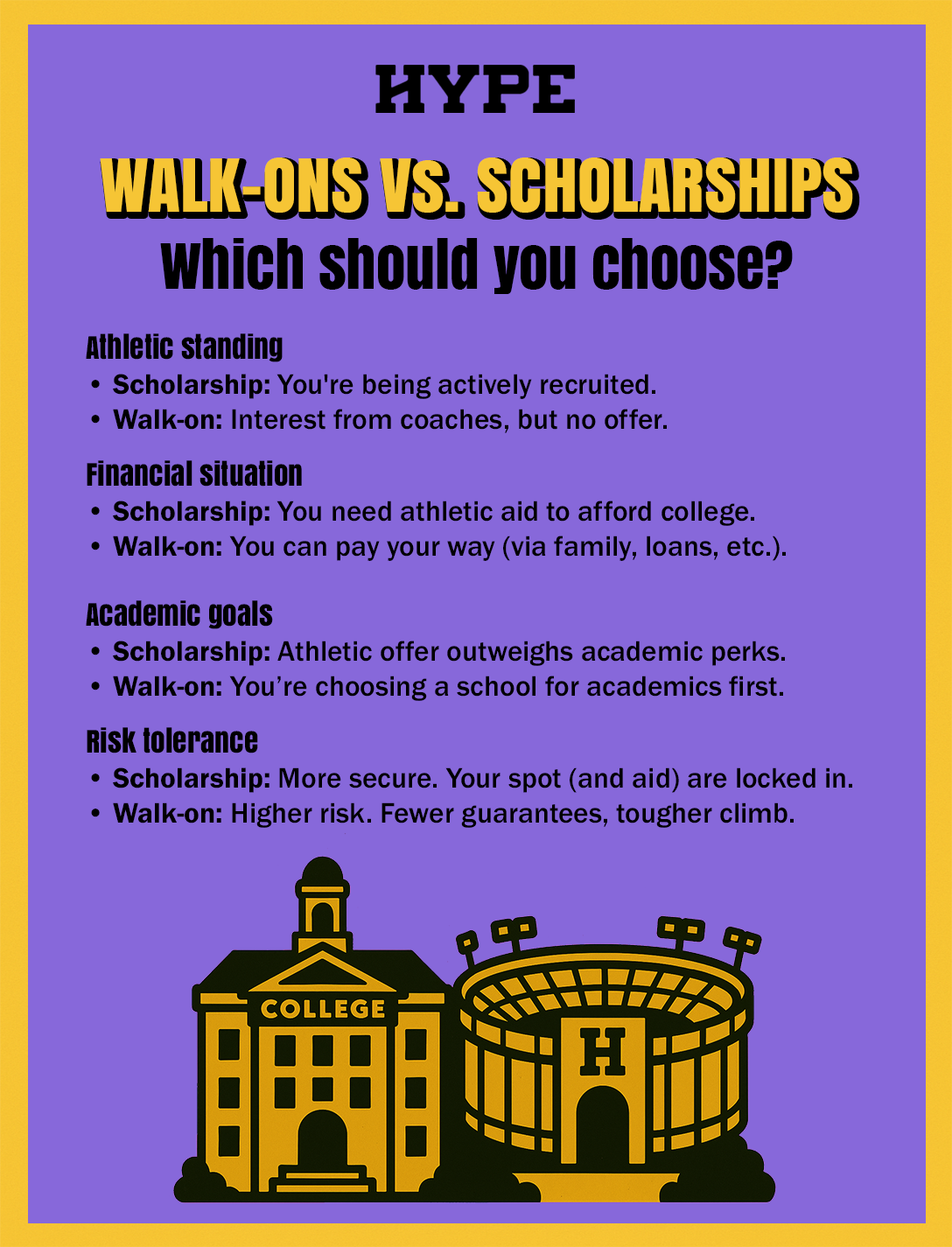
TLDR – Walk-on vs. Scholarship: Which should you choose?
Athletic standing: Scholarship: You're being actively recruited. Walk-on: Interest from coaches, but no offer.
Financial situation: Scholarship: You need athletic aid to afford college. Walk-on: You can pay your way (via family, loans, etc.).
Academic goals: Scholarship: Athletic offer outweighs academic perks. Walk-on: You’re choosing a school for academics first.
Risk tolerance: Scholarship: More secure. Your spot (and aid) are locked in. Walk-on: Higher risk. Fewer guarantees, tougher climb.
CHARTING YOUR FUTURE BEYOND THE FIELD
Whether you choose the scholarship or walk-on path, your college athletic experience builds skills that translate to life after sports. Both journeys develop valuable traits that employers and graduate schools value.
Skills developed through college athletics:
- Time management and organization
- Resilience and perseverance
- Teamwork and communication
- Performance under pressure
- Goal-setting and achievement
Walk-ons often develop additional qualities through their unique challenges:
- Self-motivation and initiative
- Resource management
- Proving value without external validation
- Overcoming obstacles with limited support
Scholarship athletes may benefit from:
- Higher visibility and networking opportunities
- More structured support systems
- Earlier leadership opportunities
Both paths can lead to successful careers in and outside of sports. Former walk-ons often point to their experience as crucial in developing grit and determination that served them well professionally. Scholarship athletes frequently leverage their visibility and connections into career opportunities.
The skills you develop as a college athlete – regardless of scholarship status – prepare you for future challenges and opportunities. Your athletic journey is just one chapter in a longer story of growth and achievement.
Whether you're on scholarship or walking on, developing the right mindset and skills is crucial for long-term success.
FAQS ABOUT WALK-ON AND SCHOLARSHIP ATHLETES
HOW DO NIL DEALS COMPARE FOR WALK-ONS VERSUS SCHOLARSHIP ATHLETES?
Scholarship athletes typically have more visibility for NIL opportunities, but walk-ons can also secure deals through personal branding and compelling stories, especially if they earn playing time.
DO WALK-ON ATHLETES RECEIVE THE SAME EQUIPMENT AND GEAR AS SCHOLARSHIP ATHLETES?
In most NCAA programs, walk-on athletes receive the same team-issued equipment and gear as scholarship athletes, though there may be limitations for non-travel squad members.
CAN WALK-ON ATHLETES TRANSFER TO OTHER SCHOOLS AND RECEIVE SCHOLARSHIPS?
Walk-on athletes can transfer to other institutions and potentially receive athletic scholarships, especially if they've proven themselves at their original school.
HOW DOES THE NEW NCAA SETTLEMENT AFFECT WALK-ON OPPORTUNITIES?
The 2025 NCAA settlement introduced roster limits that may reduce walk-on spots at many schools, making preferred walk-on status more competitive and valuable. The path of the unrecruited walk-on may disappear entirely.
